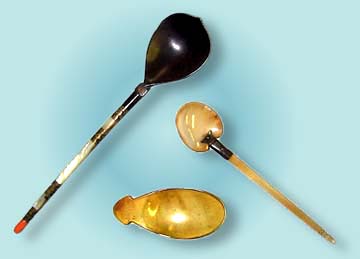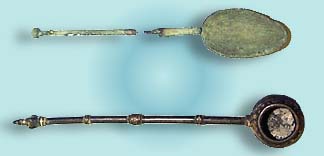


Spoons have been used as eating utensils since Paleolithic times. It is most likely that prehistoric peoples used shells or chips of wood as spoons. In fact, both the Greek and Latin words for spoon are derived from cochlea, meaning a spiral-shaped snail shell. This suggests that shells were commonly used as spoons in Southern Europe. Additionally, the Anglo-Saxon word spon, meaning a chip or splinter of wood, points toward widespread use of this material for Northern European spoons. In addition to shell and wood, spoons have also been made from metals (such as gold, silver, and pewter), ivory, bone, horn, pottery, porcelain, and crystal. The spoons above consist of a variety of materials.
In the 1st Century CE, the Romans designed two types of spoons, similar in style to the spoons below, that ultimately had far-reaching influence. The first, a ligula, was used for soups and soft foods. It had a pointed oval bowl and a handle ending in a decorative design. The second style of spoon was called a cochleare, and it was a small spoon with a round bowl and a pointed, slender handle for eating shellfish and eggs. The earliest English spoons were likely modeled after these two types of spoons due to the Roman occupation of Britain from 43 to 410 CE.

During the Middle Ages, spoons, generally made of wood or horn were supplied by dinner hosts. Royalty often had spoons made of gold, and other wealthy families generally had silver spoons. However, beginning around the 14th Century, spoons made of tinned iron, brass, pewter, and other metals, as illustrated by the spoons below, became common. The use of pewter especially made spoons more affordable for the general populace.

CAS
0389-1531: Indian spoon of bronze (left)
CAS 0389-2036: European spoon of silver (center)
CAS 0389-1750: Persian spoon of bronze (right)